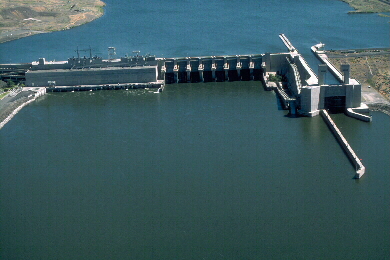forum
library
tutorial
contact

BPA Adopts 7.8 Percent
Wholesale Power Rate Increase
by Staff
Columbia Basin Bulletin, July 29, 2011
|
the film forum library tutorial contact |

|
BPA Adopts 7.8 Percent
by Staff
|
Funds Hydro Improvements, Salmon Recovery
 The Bonneville Power Administration this week adopted a 7.8 percent average wholesale power rate increase.
The Bonneville Power Administration this week adopted a 7.8 percent average wholesale power rate increase.
Agency officials say "the new wholesale power rate supports needed improvements to ensure the region's 31 federal dams and one nuclear plant can continue to reliably deliver carbon-free, affordable power to Northwest homes and businesses."
They say the main costs behind the rate increase are:
BPA says it was able to hold its 2012 - 2013 wholesale power rate increase to 7.8 percent by:
BPA also announced that, due to this year's above average water conditions, there will not be an additional within-year rate increase for fiscal year 2012. The initial rate proposal included a one-in-three chance that such a surcharge would be necessary, based on BPA's financial performance in 2011.
BPA power customers will operate under new long-term contracts for the first time this rate period. The contracts are a result of BPA's multi-year regional dialogue process. Under those contracts, BPA customers receive a designated amount of BPA power at the new lowest cost, tier one wholesale rate. Any power necessary to serve their energy needs beyond that amount will be purchased from BPA at a slightly higher rate or from the customer's own source.
"This rate period marks a new era in BPA's relationship with its customers," said Wright. "We are pleased that the transition to a new business paradigm is proceeding smoothly with very little controversy in this rate proceeding."
The new wholesale power rates would affect Northwest consumer-owned utilities such as public utility districts, tribal utilities, cooperatives, municipalities and federal entities. BPA sells power to investor-owned utilities and direct-service industries under different rate structures.
Last December, BPA and its transmission customers reached a partial settlement to avoid a transmission rate increase. Under the settlement, BPA will use some of its financial reserves to cover transmission costs, keeping rates level in fiscal years 2012 and 2013.
BPA transmission rates are separate from wholesale power rates and apply to Northwest utilities and others that transmit electricity on high-voltage BPA lines.
However, the December settlement did not cover the costs of integrating wind power and other generation into the grid or use of the Montana Intertie.
The Montana Intertie transmission rate will decrease by 54 percent. The 500-kilovolt power line integrates generation from Montana's Colstrip power plant into BPA's transmission system. BPA also is adopting a separate rate for the cost of providing services to non-federal thermal resources connected to its transmission system to ensure equitable treatment of thermal and variable energy resources.
BPA also announced it will reduce by 4.7 percent the rate for integrating wind onto its transmission grid. The total cost of integrating more wind is increasing, but the reduction is possible because of some additional geographic diversity of the wind projects connecting to the BPA transmission system and modifications to the calculation of necessary reserves.
Today, there are more than 3,500 megawatts of wind connected to the BPA transmission system. This is equivalent to the installed capacity of three typical nuclear plants. By Sept. 30, 2013, the end of this rate period, that amount is expected to grow to approximately 5,500 megawatts.
BPA anticipates having the capability to integrate the projected wind coming onto the BPA system through 2013, but is rapidly running out of system flexibility.
BPA has developed mechanisms to acquire more balancing reserves if the growing amount of wind outpaces BPA and its customers' ability to integrate it. If the need for more reserves arises, BPA has established mechanisms in this rate proceeding to pass those costs on to the customers using the service. In addition, BPA is providing options for wind generators to obtain additional service or to lower their cost by committing to adjust their schedules every half hour.
BPA is a non-profit federal agency that markets renewable hydropower from federal Columbia River dams, operates three-quarters of high-voltage transmission lines in the Northwest and funds one of the largest wildlife protection and restoration programs in the world. BPA says the agency and its partners have also saved enough electricity through energy efficiency projects to power four large American cities.
learn more on topics covered in the film
see the video
read the script
learn the songs
discussion forum
